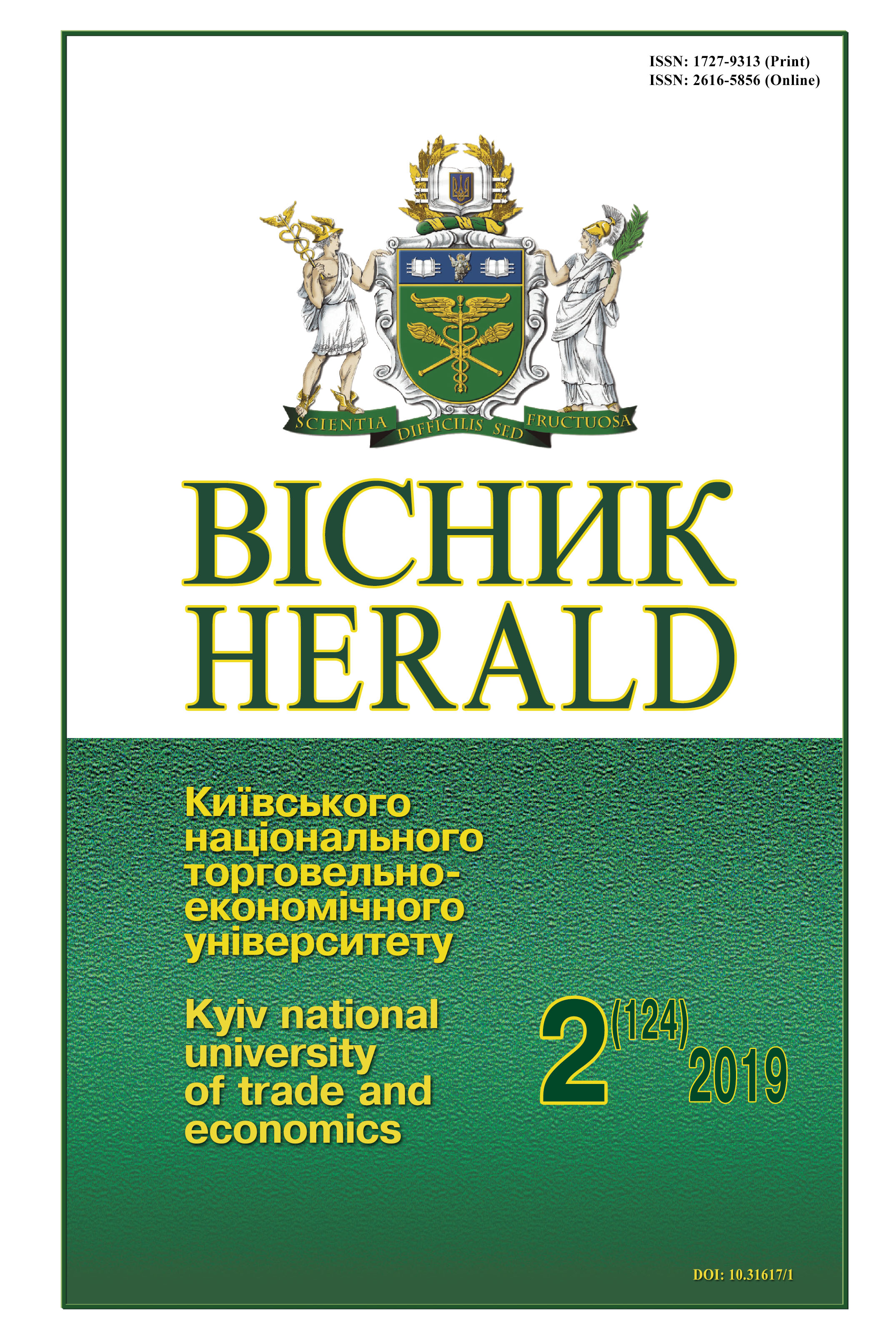Стратегії національного бренду в умовах глобалізації
DOI:
https://doi.org/10.31617/visnik.knute.2019(124)02Ключові слова:
бренд країни, національний брендинг, глобальна конкурентоспроможність країни, стратегії національного брендингуАнотація
Розраховано інтегральний індекс національного бренду на основі виділення основних компонент, що впливають на глобальну конкурентоспроможність – макроекономічної, соціальної, корпоративної та інноваційної складових. Кількісно проаналізовано внески факторів, які впливають на національний бренд. Визначено позиції країн у світі на основі зіставлення розрахованого індексу національного бренду з індексом глобальної конкурентоспроможності. Сформульовано стратегії перспективності розвитку національного бренду залежно від позиції країни в світі.
Посилання
Anholt, S. & Govers, R. (2014). The Good Country. Retrieved from http://www.goodcountry.org [in English].
Aronczyk, M. (2013). Branding the Nation – The Global Business of National Identity. New York: Oxford University Press [in English].
Mariutti, Fabiana, & Tench, Ralph (2016). How does Brazil measure up? Comparing rankings through the lenses of nation brand indexes. Place branding and public diplomacy. (Vol. 12). Is. 1, 17-31 [in English].
Kanji, L. (2016). Illustrations and Influence: Soft Diplomacy and Nation Branding through Popular Culture. Harvard International Review. (Vol. 37), 2, 40-43 [in English].
Dinnie, K. (2016). Nation Branding: Concepts, Issues, Practice. 2nd ed. Oxon: Routledge. Google Scholar [in English].
Zugic, Jelena & Konatar, Aleksandar (2018). Comparative analysis of the value of Nation Brands. Ekonomski vjesnik, 1, 179-191 [in English].
Temporal, P. (2014). Branding for the Public Sector: Creating, Building and Managing Brands People Will Value. Retrieved from http://site.ebrary.com.ezproxy.jamk.fi:2048/lib/jypoly/detail.action?docID=10990950 [in English].
Van Garderen, G. (2014). The Brand Advantage in Economic Development: Creating Unique Nation Brands to Promote Tourism, Trade and Foreign Direct Investment. Harvard Kennedy School Review. (Vol. 14). (pp. 83-87) [in English].
Polishko, G. G., & Lytvyn, M. V. (2015). Globalizacija jak peredumova brendyngu krai’n svitu [Globalization as a prerequisite for branding of countries around the world]. Ekonomichnyj prostir – Economic space, 103, 24-34 [in Ukrainian].
Shtel’mashenko, A. D. (2014). Aspekty formuvannja brenda derzhavy: zakordonnyj dosvid [Aspects of forming the brand of the state: foreign experience]. Visnyk Kyi’vs’kogo nacional’nogo universytetu imeni Tarasa Shevchenka. Derzhavne upravlinnja – Bulletin of the Taras Shevchenko National University of Kyiv. Public administration. (Vol. 1). (pp. 94-97). Retrieved from http://nbuv.gov.ua/UJRN/vknud_2014_1_29 [in Ukrainian].
Jaremko, Z. M., & Tkach, G. V. (2016). Shhodo nacional’nogo brendyngu v Ukrai’ni v konteksti prosuvannja i’i’ interesiv u sviti [About national branding in Ukraine in the context of promoting its interests in the world]. Molodyj vchenyj – Young scientist,12.1,1035-1040. Retrieved from http://nbuv.gov.ua/UJRN/molv_2016_12 [in Ukrainian].
Veleshhuk, S. S. (2015). Terytorial’nyj brendyng jak instrument social’no-ekonomichnogo rozvytku regionu [Territorial branding as an instrument of socio-economic development of the region]. Stalyj rozvytok ekonomiky – Sustainable development of the economy, 3, 146-152. Retrieved fromhttp://nbuv.gov.ua/UJRN/sre_2015_3_22 [in Ukrainian].
Ignat’jeva, V. (2015). Vykorystannja suchasnyh instrumentiv stvorennja terytorial’nogo brendu [Use of modern tools to create a territorial brand]. Zbirnyk tez dopovidej uchasnykiv Vseukrai’ns’koi’ konferencii’ – Collection of theses of reports of the All-Ukrainian conference participants, (Cherkasy, April 15-17, 2015), (pp. 67-68). Cherkasy: Shidnojevropejs’kyj universytet ekonomiky ta menedzhmentu [in Ukrainian].
Kuz’muk, O. (2018). Terytorial’nyj brendyng jak instrument miscevogo rozvytku [Territorial branding as a tool for local development]. Visnyk L’vivs’kogo universytetu – Bulletin of Lviv University. (Vol. 16). (pp.156-161). Retrieved from http://nbuv.gov.ua/UJRN/Vlu_fps_2018_16_24 [in Ukrainian].
Nagornjak, T. L. (2014). Brendyng terytorij u suchasnyh politychnyh praktykah [Branding of territories in modern political practices]. Grani – Grani, 3, 53-58. Retrieved from http://nbuv.gov.ua/UJRN/Grani_2014_3_11 [in Ukrainian].
Amosov, O. Ju., Didenko, N. V., & Lebjedjeva, K. Ju. (2015). Brendyng jak osnovnyj instrument marketyngu v Ukrai’ni [Branding as the main marketing tool in Ukraine]. Investycii’: praktyka ta dosvid – Investments: practice and experience, 12, 10-12. Retrieved from http://nbuv.gov.ua/UJRN/ipd_2015_12_4 [in Ukrainian].
Lyulyov, O., Chygryn, O., & Pimonenko, T. (2018). National Brand as a Marketing Determinant of Macroeconomic Stability. Marketing and Management of Innovations, 3, 142-152. Retrieved from:http://doi.org/10.21272/mmi.2018.3-12 [in English].
Oficijnyj sajt statystyky OESR [OECD Official Statistics Website]. stats.oecd.org. Retrieved from https://stats.oecd.org [in Ukrainian].
Eurostat indicators on High-techindustry and Knowledge – intensive services. Annex 3 – High-techaggregationbyNACERev.2. ec. europa.eu Retrieved from http://ec.europa.eu/eurostat/cache/metadata/Annexes/htec_esms_an3.pdf [in English].
General government gross debt, % GDP/IMF, World Economic Outlook Database. www.imf.org. Retrieved from http://www.imf.org/external/pubs/ft/weo/2018/01/weodata/weoselgr.aspx [in English].
Statistical Indicators of UNCTADstat. unctadstat.unctad.org. Retrieved from http://unctadstat.unctad.org/wds/ReportFolders/reportFolders.aspx?sCS_ChosenLang=en [in English].
Kaiser, H. F. (1960). The application of electronic computers to factor analysis. Educational and Psychological Measurement, 20, 141-151. Retrieved from http://dx.doi.org/10.1177/001316446002000116 [in English].
Afifi, A. & Jejzen, S. (1982). Statisticheskij analiz. Podhod s ispol’zovaniem JeVM [Statistical analysis. Computer-aided approach]. Мoscow: Mir [in Russian].
Harman, G. G. (1972). Sovremennyj faktornyj analiz [Modern factor analysis]. Мoscow: Statistika [in Russian].
Efremov, V. S. (2001). Klassicheskie modeli strategicheskogo analiza i planirovanija: model’ Shell/DPM [Classic strategic analysis and planning models: model Shell/DPM]. Korporativnyj menedzhment – Corporate Management, 3 [in Russian].
Tompson, A. A., & Striklend, A. Dzh. (2007). Strategicheskij menedzhment: koncepcii isituacii dlja analiza [Strategic management: concepts and situations for analysis]. 12-e izd.; per. s angl. Мoscow: Vil’jams [in Russian].
Hichens, R. E., & Robinson S. J. (1978). The directional policy matrix: tool for strategic planning. Wade Long Range Planning. (Vol. 11) (June). (pp. 8-1) [in English].
The Global Competitiveness Report 2017-2018. World Economic Forum. Geneva. 393р. [in English].







